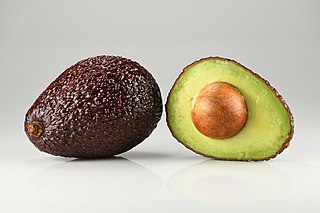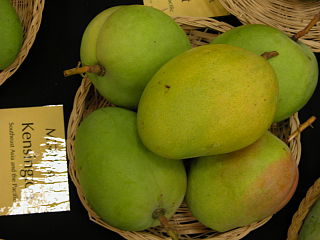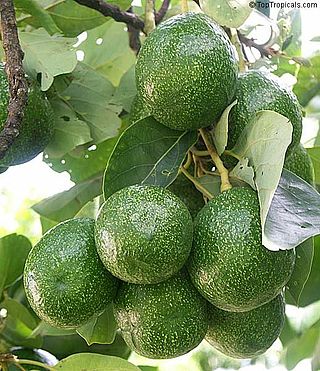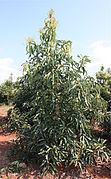
A mango is an edible stone fruit produced by the tropical tree Mangifera indica. It is believed to have originated in southern Asia, particularly in eastern India, Bangladesh, and the Andaman Islands. M. indica has been cultivated in South and Southeast Asia since ancient times resulting in two types of modern mango cultivars: the "Indian type" and the "Southeast Asian type". Other species in the genus Mangifera also produce edible fruits that are also called "mangoes", the majority of which are found in the Malesian ecoregion.

A plum is a fruit of some species in Prunus subg. Prunus. Dried plums are most often called prunes, though in the United States they may be just labeled as 'dried plums', especially during the 21st century.

Prunus cerasus is a species of Prunus in the subgenus Cerasus (cherries), native to much of Europe, North Africa and West Asia. It is closely related to the sweet cherry, but has a fruit that is more acidic. Its sour pulp is edible.

The avocado is a medium-sized, evergreen tree in the laurel family (Lauraceae). It is native to the Americas and was first domesticated in Mesoamerica more than 5,000 years ago. Then as now it was prized for its large and unusually oily fruit. The tree likely originated in the highlands bridging south-central Mexico and Guatemala. Its fruit, sometimes also referred to as an alligator pear or avocado pear, is botanically a large berry containing a single large seed. Sequencing of its genome showed that the evolution of avocados was shaped by polyploidy events and that commercial varieties have an hybrid origin. Avocado trees are partly self-pollinating, and are often propagated through grafting to maintain consistent fruit output. Avocados are presently cultivated in the tropical and Mediterranean climates of many countries. Mexico is the world's leading producer of avocados as of 2020, supplying nearly 30% of the global harvest in that year.

Feijoa sellowiana also known as Acca sellowiana (O.Berg) Burret, is a species of flowering plant in the myrtle family, Myrtaceae. It is native to the highlands of southern Brazil, eastern Paraguay, Uruguay, and northern Argentina. Feijoa are also common in gardens of New Zealand. It is widely cultivated as an ornamental tree and for its fruit. Common names include feijoa, pineapple guava and guavasteen, although it is not a true guava. It is an evergreen shrub or small tree, 1–7 metres (3.3–23.0 ft) in height.

Gala is an apple cultivar with a sweet, mild flavour, a crisp but not hard texture, and a striped or mottled orange or reddish appearance. Originating from New Zealand in the 1930s, similar to most named apples, it is clonally propagated. In 2018, it surpassed Red Delicious as the apple cultivar with the highest production in the United States, according to the US Apple Association. It was the first time in over 50 years that any cultivar was produced more than Red Delicious.

The Hass avocado is a variety of avocado with dark green, bumpy skin. It was first grown and sold by Southern California mail carrier and amateur horticulturist Rudolph Hass, who also gave it his name.
Sphaceloma perseae is a plant-pathogenic fungus in the division Ascomycota. It infects the avocado plant, a tree native to Central America and Mexico. Currently there are three cultivars of avocados in large-scale agricultural production: Guatemalan, Mexican, and West Indian. The pathogen is currently limited to the P. Americana species but is able to infect all three cultivars. The resulting disease is known as avocado scab for the symptoms which are present on the fruit of the avocado tree. It is believed that the disease developed in Florida in the early twentieth century and is related to citrus scab, Elsinoe fawcetti. Since then, S.perseae has spread to many regions worldwide that support cultivation of the avocado tree. This pathogen threatens the global avocado market, including both importers and exporters of the crop. Countries which import avocados, including the United States, have experienced a rising demand over the past decade which is projected to continue for years to come. An understanding of avocado scab characteristics and feasible prevention methods is essential to maintenance of cultures and economies influenced by the avocado fruit.
Rudolph Gustav Hass was an American mail carrier and amateur horticulturist who first grew the Hass avocado, the source of 95% of California avocados grown commercially today.

The 'Glenn' mango is a mango cultivar that originated in South Florida.

The fig is the edible fruit of Ficus carica, a species of small tree in the flowering plant family Moraceae, native to the Mediterranean region, together with western and southern Asia. It has been cultivated since ancient times and is now widely grown throughout the world. Ficus carica is the type species of the genus Ficus, containing over 800 tropical and subtropical plant species.

The 'Cogshall' mango is a named mango cultivar that originated in southwest Florida.

The 'Julie' mango, also called 'Saint Julian', is a named mango cultivar that was made popular in the Caribbean.

The 'Kensington Pride' mango is a named commercial mango cultivar that originated in Australia. It is sometimes called the KP, Bowen or Bowen special. It is Australia's most popular mango, accounting for over 80% of the country's annual commercial mango market. It is considered to have a distinctive flavour and aroma when compared with the Florida-bred cultivars grown by most mango-exporting countries.

The 'Lancetilla' mango is a named mango cultivar that originated in Honduras.
The Brogdenavocado is a named cultivar of avocado that originated in Florida.
The 'Lula' avocado is an avocado cultivar that originated in south Florida.
The Monroe avocado is a commercial named cultivar of avocado that originated in south Florida.

The Choquette avocado is a named commercial cultivar of avocado that originated in south Florida.

Avocado production is important to the economy of Mexico with the country being the world's largest producer of the crop. Mexico supplies 45 percent of the international avocado market. Of the 57 avocado producing countries, the other major producers are Dominican Republic, Peru, Colombia, and Indonesia, in that order.

















